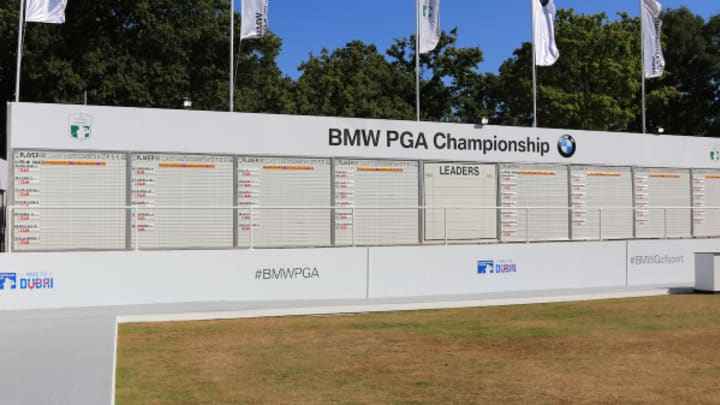Clock starts on European Tour's dawdlers

In a couple of months, we’ll learn whether the European Tour is all talk, no action.
Meanwhile, the Euro Tour this week offers a glimpse of its much-ballyhooed “four-point plan to tackle slow play” at the BMW PGA Championship, where a trial of the tour’s new pace-of-play timing system will feature on-tee displays that provide players with real-time information on their position in relation to the group in front.

© GOLFFILE/THOS CAFFREY
The European Tour will roll out its new pace-of-play policy at this week's BMW PGA Championship.
The timing of the timing system trial couldn’t be more perfect, after last week’s Solheim Cup, where the pace – even conceding the challenging weather at Gleneagles and the inherently slower match-play format – was an inexcusable display of contempt for the spirit, traditions and supposed values of golf.
The Euro Tour’s four-point plan (the points being regulation, education, innovation, field sizes) is slated to be implemented at a “significant number” of European, Challenge and Staysure (senior) tournaments in 2020. Here’s a refresher summary of the plan:
* A new timing system will eliminate what essentially has been a grace period for players who fall out of position. Under current guidelines, a breach-of-time allowance prompts officials to “monitor” said player, meaning he will be “officially timed” and incur a one-shot penalty after two more breaches of his time limit. Beginning next season, when players are deemed to be out of position, a one-shot penalty will be incurred after a second bad time.
* Referees will be provided with times for every group through every hole, in an effort to make sure that no gaps are missed. On-tee displays will provide groups with their position in relation to the group in front.
* Meanwhile, in-position timing has been modified for 2020 by reducing the time allowed to play a shot by 15 percent, from 100 and 80 seconds down to 85 and 70 seconds, respectively, for first and second/third to play. Referees have been instructed to target known slow players for in-position timing – a controversial ploy, given the subjectivity of “slow” and the potential for favoritism.
* A player-education component is in the works. New tour members will be assigned a referee to tutor them on pace of play; all members will be required to pass an interactive online rules test (and be retested every three years); and the tour will produce educational videos on key rules and pace-of-play policies, to be shared with players throughout each season.
* Field sizes at fully sanctioned European Tour events will be reduced by roughly 10 players when possible, depending on necessary accommodations to those in eligibility Category 18 (final 111-125 on previous season’s Race to Dubai). Intervals between starting times will be increased during rounds 3 and 4 of each tournament.
As for this week’s BMW PGA at Wentworth, where the European Tour is headquartered, the timing-system trial figures to take place largely behind the scenes, as referees and rules staff give the procedures an inaugural dry run. But the time displays on five tee boxes are sure to prompt chatter among the contestants (tee times). Timing data will be compiled using GPS devices attached to one player’s bag in each group. (Caddies, be warned: Don’t lollygag in the loo.)
The European Tour recently published an open letter from its chief executive, Keith Pelley, which provided background on the pace-of-play initiative and advised patience.
“Although superficially solving the pace of play conundrum would seem like an easy fix, golf’s biggest challenge remains the size of our arena, as an 18-hole golf course is equivalent to almost 90 football fields, with 156 players dotted around it,” Pelley wrote. “Timing every player, on every shot, every week is a monumental, and costly, challenge.”
Pelley also took a jab at the PGA Tour, which refuses to acknowledge the severity of golf’s slow-play problem.
“This is now the lightbulb moment for our sport, but it is incumbent on all of us involved in golf to act,” Pelley wrote. “The main tours and four major championships have begun dialogue, but as the most powerful entities in global golf, we have to be united and consistent in fighting this battle if it is one we are to win.”
The PGA Tour brain trust in Ponte Vedra Beach, Fla., continues to study the issue. You can be sure that the discussions center around how to monetize any policy changes.
For instance, the competition among watch companies for the Tour license to provide branded shot clocks on every tee box would be fierce.
Surely there’s a Silicon Valley company willing to pay the PGA Tour for the right to affix mini-transponders to competitors’ shirts, which would advance the Euro Tour’s innovation by timing each player individually during rounds.
The Tour could ban the use of yardage books and instead allow rangefinders, yet another high-profile licensing opportunity.
Or how about the chance to be the “Official Body Camera of the PGA Tour”? Players would be required to wear body cams for the purpose of alerting officials to situations in which a ruling is required. Just as the NFL reviews plays at the league’s New York headquarters, rules officials in Ponte Vedra would be able to make most calls remotely. As needed, roving rules officials could be summoned quickly.
Bottom line, the PGA Tour is content to let its European counterpart be the pace-of-play guinea pig. Which is no surprise, because every move that the American tour makes is based not on the good of the game, but rather on how much it might add to the organization’s tax-exempt coffers.
Dave Seanor has been a sports journalist since 1975, including a 13-year stint as editor of Golfweek magazine. He has covered golf in 25 countries, including the 2016 Olympics in Brazil. Email: daveseanor@gmail.com
